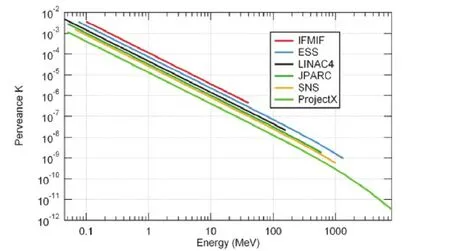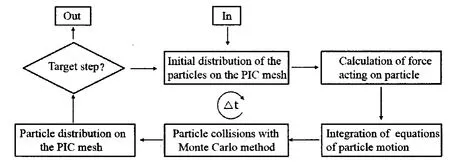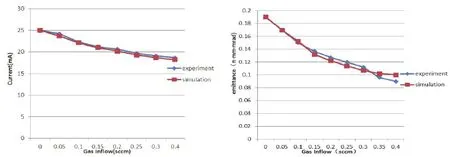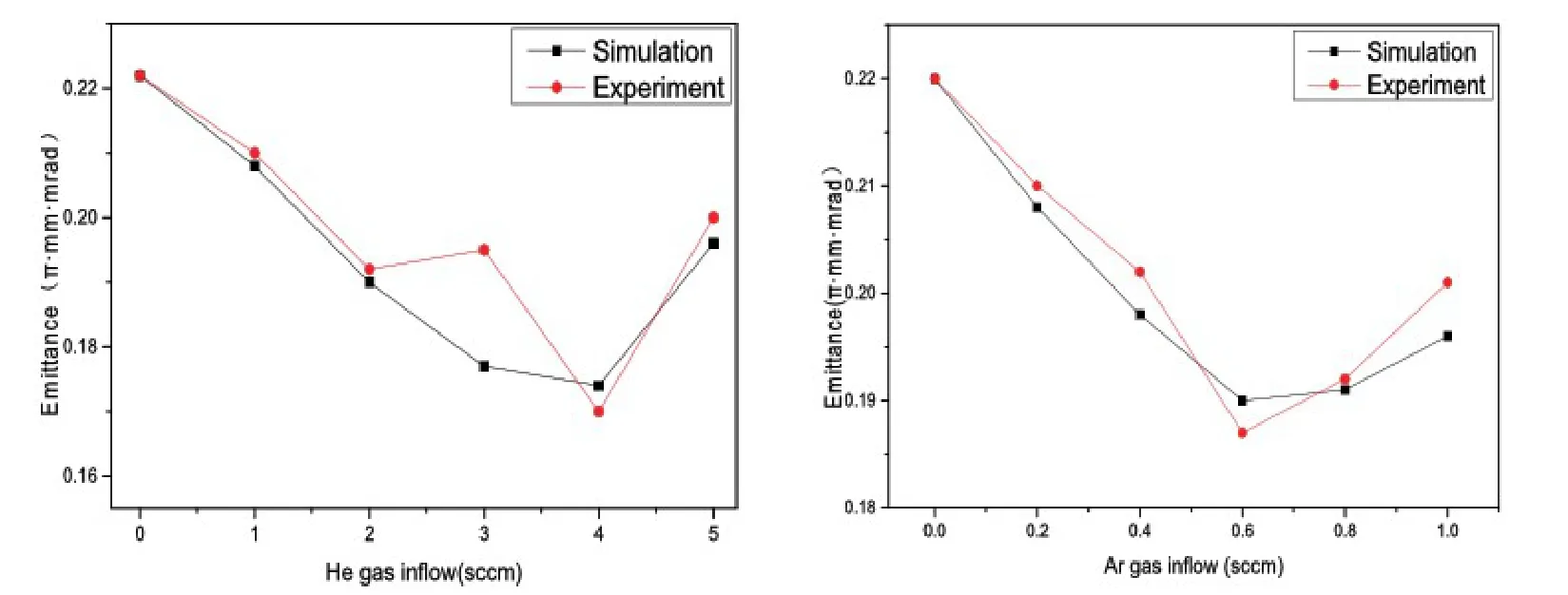Review on Space Charge Compensation in Low Energy Beam Transportation
ZHANG Ailin, PENG Shixiang, REN Haitao, ZHANG Tao,ZHANG Jingfeng, XU Yuan, WEN Jiamei, WU Wenbin,GUO Zhiyu, CHEN Jiaer
(1.State Key Laboratory of Nuclear Physics and Technology &Institute of Heavy Ion Physics,School of Physics,Peking University,Beijing 100871,China;2.University of Chinese Academy of Sciences,Beijing 100049,China)
Review on Space Charge Compensation in Low Energy Beam Transportation
ZHANG Ai-lin1,2, PENG Shi-xiang1, REN Hai-tao1, ZHANG Tao1,ZHANG Jing-feng1, XU Yuan1, WEN Jia-mei1, WU Wen-bin1,GUO Zhi-yu1, CHEN Jia-er1,2
(1.State Key Laboratory of Nuclear Physics and Technology &Institute of Heavy Ion Physics,School of Physics,Peking University,Beijing 100871,China;2.University of Chinese Academy of Sciences,Beijing 100049,China)
Demands of high intensity accelerators are increasing for fundamental science research and engineering applications.In such kinds of accelerators,the beam in low energy parts is space charge dominated.This can result in large and irreversible emittance growth.Space charge compensation which occurs by tapping opposite polarity of the particle of the beam is a helpful way to overcome the effect caused by the space charge.An extended particle in cell(PIC)code jointed with the Monte Carlo collision(MCC)has been developed in Peking University(PKU)for modeling the space charge compensation.In the meantime,experiments of low energy H+and H-ion beam have been carried out.The results of the numerical simulation agree well with the experiment ones for both H+beam[1]and H-beam[2].Details will be presented in this paper.
high intensity accelerators;low energy parts;space charge effect;space charge compensation;PIC-MCC
Classification No:O57Document code:APaper No:1001-2443(2016)03-0205-09
Introduction
High power accelerators can give rise to a large variety of scientific applications,used for both fundamental research and application research.Several projects of high current accelerator have been built and are now in commissioning or operational phases,such as the spallation neutron sources(SNS[3],CSNS[4],and ESS[5]),the muons factories(J-PARC[6],and ISIS[7]),the radioactive ion beams production(FAIR[8],and SPIRAL2[9]),the international fusion materials irradiation facility(IFMIF)[10],and accelerator driven sub-critical system(ADS)[11].Space charge effect and space charge compensation are important issues along the whole high intensity accelerators.In high energy case,space charge induced tune shift and beam stabilization.In low energy section,the beam is space charge dominated which can result in large and irreversible emittance growth.Such a beam usually need space charge compensation to control the space charge effect.
The space charge compensation occurred by tapping opposite polarity of the particles could come from the

secondary particles produced by gas ionization or supplied by specific device.For gas ionization,it takes time for a particle of the beam to produce a neutralizing particle on the gas.It is expressed as, whereσiis the ionization cross section of the incoming particles on the gas and ngis the gas density in the beam line.The gas space charge compensation only applies to those beam whose pulse length is longer thanτ,for example CW beam or long-pulse beam.For those short pulsed beam,the opposite polarity of the particles should be initiatively provided and sustained by specific device without transient time limit,such as Electron Volume[12]and Gabor Lens[13].In this paper,we will focus on the space charge effect and space charge compensation of CW beam and long-pulse beam.
Study on space charge compensation can help us to understand the processes during the compensation and guide accelerator design.Experiment research as well as numerical simulation are complementary ways on this study.To simulate the process of space charge compensation within an ion beam,the space charge effect should be treated by taking into account either through a linear analytical model or by treating the beam fully three-dimensional through particle-in-cell(PIC)methods.At PKU,a Monte Carlo collision (MCC)[14]package including the null collision method has been developed as an addition to the usual PIC charged particle scheme.This PIC-MCC code done with 2DMATLAB code has been used to simulate the space charge compensation of H+beam.The simulation results had a good agreement with the experimental ones when dealing with Ar compensating H+beam[1].Recently,this PIC-MCC simulation code was improved to 3Dmodel and had been used in the H-beam after considering the difference of positive and negative ion beams[2].Again,the results obtained by H-beam experiment were coincident well with the numerical results.Space charge effect and space charge compensation,and experiment and simulation of space charge compensation will be presented in the paper.
1 Space charge effect
Space charge is the most fundamental of the collective effects whose impact generally is proportional to the beam intensity.The defocusing force of space charge effect will lead to emittance growth(εrms)[14].It can be expressed by the generalized perveance K,

Here Xis the position of the ions in the beam,ΔWnlis the normalized non-linear field energy which is mainly determined by the density distribution of the ion beam.The generalized perveance,a dimensionless parameter K,is defined as,

The perveance Krefers to the magnitude of space-charge effects in a beam,and it will largely determine the particle trajectories in drift region.In equation(3),Iis the density of the beam,while we approximate thatΔWnl∝I,from equation(1)we getΔεrms∝I,which means the emittance growth is proportional to beam current.
Figure 1showed the perveance Kunder different energy in several high current projects[15].As shown in Fig.1,in low energy region(100keV)the perveance Kis 5×10-3,five orders higher than that in the high energy region(100MeV).From equation(1)we know thatΔεrmsis proportional to.This means the emittance growthΔεrmscaused by space charge effect in low energy is hundreds times larger than it in the high energy region.Therefore the following discussion will focus on the low energy part of accelerator.
Low energy beam transportation(LEBT)is a beamline that connects ion source and the acceleratingstructure whose energy is usually tens kV to hundreds kV.Emmitance growth will be the significant problem according to Figure 1and equation(2).The space charge in LEBT of the high intensity accelerators should be compensated carefully.

Figure 1 The perveance K under different energy in several projects[15]
2 Space charge compensation
The most common way for space charge compensation in low energy parts of accelerator is gas ionization,and the gas could come from residual gas or initiatively injecting.Figure 2is an example[16].When a proton beam is propagating through the gas of the beam line,the proton beam will ionize the molecules of residual gas or injected gas within the vacuum pipe,the electrons will be absorbed to the beam core while the ions are expelled from the beam core,this results that the beam will be neutralized,it’s so called space charge compensation.

Figure 2 Proton beam compensated with gas ionization[16]
The space charge compensation can be particularly different from each other under different electromagnetic environment.The ions that generated within an ion source body are formed as an ion beam through a beam extraction system.When an extraction electric field applied on the ion source,the wanted sign particles will be extracted from the plasma while the opposite charge particles will be decelerated and reflected towards the plasma.To avoid the compensating particles lost towards the ion source,an acceldecel extraction system has to be used in GSI[17].The experimentally observed beam profiles using viewing targets and the simulation using the three-dimensional 3Dsimulation code KOBRA3-INP[18]have a good agreement.Figure 3showed a simulation result concentrating on magnetic field line and extraction aperture from KOBRA3-INP.
Once the beam is extracted from the ion source,it has to be transported and matched by the lowenergy beam transportation(LEBT)to the first accelerating structure such as a RFQ.The focus can be done with electrostatic or magnetic elements[19].

Figure 3 Magnetic field lines going on different radius through the extraction aperture:1mm,2mm,and 6mm[18]
Electrostatic LEBT mainly consists of axisymmetric electrostatic focusing components.These lenses are affecting the beams by the electric field they generated so to adjust the beam transmission parameters to achieve the goal of matching the beam emittance with the cavity acceptance.The electrostatic LEBT is compatible with fast beam chopping as there is no transient time for the space charge compensation.The beam is propagating in electrostatic LEBT without any space charge compensation because the neutralizing particles are repelled by the electric field induced by the focusing elements.The injector developed by PKU for the DWA(Dielectric Wall Accelerator)[20]is a typical electrostatic injector,which consists of an ion source and a 20cm six electrodes LEBT.The SNS(Spallation Neutron Source)injector shown in Figure 4 is composed by an H-ion source with a 12cm long electrostatic LEBT equipped with two Einzel lenses.
Nowadays,it is commonly accepted that an optimal LEBT for high current accelerator applications consists of focusing solenoids with space charge compensation.Such magnetic LEBT is spark free and low sensibility to beam loss,and beam diagnostics and mass separation can be easily inserted.However,the pulse rise time in magnetic LEBT which is dominated by the transient time of the space charge compensation should be no shorter than hundreds of s.Two-solenoid Magnetic LEBTs have been successfully used for high current(>100mA)proton beam[22-24].Figure 5showed a schematic view of the designed two-solenoid magnetic LEBT in SNS.It consists of solenoids S1and S2that focus the H-beam into the RFQ entrance at the right,separated by 50cm used for pumping and beam diagnostics.

Figure 4 The electrostatic LEBT of SNS[21]
The constellation effect of the beam maybe lead to instability in anywhere the space charge compensation occurs.The partial space charge compensation can be unstable because of the nonlinear fluctuating electric fields created by complex motion of compensating particles(electrons and ions)in the beam's potential well[25].The strong beam instability connected with secondary particle oscillations in the beam potential was observed and described in[26,27].A first theory of this instability was developed by Chirikov[28]and a kinetic description with quadrupole oscillations was presented in[25].Reviews with further development in this field,named now e-p instability(or electron cloud effect)were presentedin[30-32].Now this instability is a main limiting factor of beam performance in the Large Hadron Collider (LHC)in CERN,including some beam transfer lines and in many other accelerators and storage rings[30,32].
3 Simulation for space charge compensation
Simulation codes can take space charge compensation into account either by a linear analytical model (as for example presented in Reiser[33])or by treating the beam fully three-dimensional through numerical simulation methods[1].The original analytical formula about space charge compensation was presented in 1968by Nezlin M V[34].Then,in 1977Gabovich published a detailed review article on the processes involved in compensation and decompensation of positive and negative high intensity ion beams considering dynamic and decompensation of the ion beams as well as collective processes in the beam plasma[35].With the development of computer technology,numerical simulation becomes more and more reliable.Numerical simulation codes for space charge compensation had been developed in many labs,such as WARP[36]developed in Lawrence Berkeley National Laboratory(LNBL),SOLMAXP[37]developed at CEA/ Saclay,and IBSimu[38]3Dsimulation code developed at CERN.However,the collisions in those codes are not calculated accurately enough.At PKU,a PIC-MCC code concentrated on collisions had been developed in PKU.Beam loss and instability caused by collisions were carefully treated within this code.Its scheme of PIC-MCC simulation is shown in Figure 6.This is similar to the input/output routines of any other numerical tool.

Figure 5 The two-solenoid magnetic electrostatic LEBT of SNS[24]

Figure 6 Scheme of the PIC-MCC simulation in PKU
In order to verify the PIC-MCC model,experiments were performed on PKU Ion Source Test Bench.Figure 7is a photo of this bench[39].It consists of a set of microwave system,the permanent magnet 2.45GHz ECR ion source,a tri-electrode extraction system,and a beam diagnostic section with a Faraday Cup(FC1)that integrates a set of slit-grid emittance measurement device.Compensation gas is injected in the same section of FC1.Mass Flow Controller was used to control the compensation gas flow.
4 Comparison of experimental results and simulation ones on space charge compensation
4.1H+beam results
The PIC-MCC model for H+beam concentrates on the scattering effect which can cause particle loss.Experiment of the space charge compensation using Ar in H+beams is presented in this paper.Ion beamswere transported through 300mm of drift section under various vacuum conditions.The simulation result is shown in Figure 8.Comparisons between the 2DPIC-MCC simulations(Figure.9)and the experiment showed the numerical results had a good agreement with the experiment.By studying the scattering effect,we found out an appropriate compensation circumstance to get the best efficiency in Low-energy Beam Transport.

Figure 7 Skeleton diagram of PKU ion source test bench[39]

Figure 8 2Dsimulation result for H+beam(compensate with 0.05sccm Ar)

Figure 9 Current(left)and emittance(right)comparison between experiment and simulation for H+beam
4.1H-beam results
The 2DPIC-MCC was improved to simulate the space charge compensation of H-beam in PKU.The biggest difference between compensation of positive and negative ion beams are the masses of the electrons and ions produced by gas ionization.In a negative ion beam,the space charge effect is neutralized by heavy positive ions while positive beam is neutralized by light electrons.The results are that the negative beammaybe overcompensated because the ion is harder to be moved than the electrons.Experiments were done at PKU ion source test bench.Compensation gas He and Ar were injected directly into the beam transport region to modify the space charge compensation degree.The 2DPIC-MCC was improved to a 3DMATLAB PIC-MCC code.Figure 10showed an example of the 3Dsimulation result of H-beam transport 50mm to faraday cup.In this case,the beam focal point,the electron temperature is 10.8eV,the max electron density on axis is about 5.8×1015m-3,the Debye length is about 1.7mm and the plasma frequency is about 2.7GHz.

Figure 10 Simulation for H-beam transport 50mm to faraday cup

Figure 11 Simulation and experiment comparison on current and ratio for H-beam

Figure 12 Simulation and experiment comparison on emittance for H-beam.The minimum emittance is the cation where it is believed the space charge compensation is optimum.For He 4sccm,while for Ar is 0.6sccm.
Figure 11showed that the simulation results of current of H-and ratio of H-to total beam current have good agreement with the experimental ones.Emittances are calculated and compared in Figure 12.Both He and Ar can reduce the space charge effect in H-beam transportation.However,to get the bestemittance result more than 6times He inflow(4sccm)is needed than Ar(0.6sccm).The simulation results agree well with the experiments and it will help us to find a good compensation circumstance to avoid the decompensation and overcompensation region in H-beam.
5 Summary
In this paper we reviewed the space charge compensation in LEBT.Until now,the beam dynamics simulations of LEBTs have been done with particle tracking codes.The PIC-MCC code developed in PKU had been used to model the space charge compensation,and it has a good agreement with the experiment which was performed on PKU ion source test bench.The simulation result agrees well with the experiments.That helps us to understand the process during the compensation in H+beam and H-beam,and guides us to find a good compensation circumstance to improve the transmission efficiency for LEBT.It has been demonstrated that numerical simulation code PIC-MCC developed in PKU can be used for injectors design of high intensity accelerators.
[1] ZHANG A L,PENG S X,REN H T,et al.Simulation study of space charge compensation in low energy beam transport[C].In proceedings of CPAC’14,Wuhan,China,2014,AT007.
[2] ZHANG A L,PENG S X,REN H T,et al.Study on space charge compensation in negative hydrogen ion beam[J].Review of Scientific Instruments,2016,87(2):02B915.
[3] HENDERSON.Status of the spallation neutron source:machine and science[C].Particle Accelerator Conference,2007PAC IEEE IEEE,2007:7-11.
[4] WEI J,FANG S X,FENG J,et al.China spallation neutron source design[C].APAC,2007:77660.
[5] CHAUVIN N,DELFERRIèRE O,DUPERRIER R,et al.Transport of intense ion beams and space charge compensation issues in low energy beam lines(invited)a)[J].Review of Scientific Instruments,2012,83(2):02B320.
[6] YAMAZAKI Y.Accelerator technical design report for high-intensity proton accelerator facility project,J-PARC KEK-Report 2002-13 [J].JAERI-Tech,2003,(1):44.
[7] FINDLAY D J S.ISIS-pulsed neutron and muon source[C].Particle Accelerator Conference,2007PAC IEEE,2007:695-699.
[8] BOINE-FRANKENHEIM O.Proceedings of the 1st International Particle Accelerator Conference IPAC’10[J].Kyoto Japan,2010,(1):280.
[9] FERDINAND R,JUNQUERA T,BOSLAND P,et al.The SPIRAL2superconducting linac[J].Proceedings of LINAC08,Victoria BC Canada,2008,(1):20.
[10] MOSNIER A,RATZINGER U.IFMIF accelerators design[J].Fusion Engineering and Design,2008,83(7):1001-1006.
[11] KAPOOR S S.Accelerator-driven sub-critical reactor system(ADS)for nuclear energy generation[J].Pramana,2002,59(6):941-950.
[12] SHILTSEV V,KAPIN V,KUZNETSOV G,et al.The use of ionization electron columns for space-charge compensation in high intensity proton accelerators[C].AIP Conf Proc 2009,1086(FERMILAB-CONF-08-395-APC):649-654.
[13] MEUSEL O,POZIMSKI J,JAKOB A,et al.Low energy beam transport for HIDIF[J].Nuclear Instruments and Methods in Physics Research Section A:Accelerators Spectrometers Detectors and Associated Equipment,2001,464(1):512-517.
[14] NGHIEM P A P,CHAUVIN N,COMUNIAN M,et al.Dynamics of the IFMIF very high-intensity beam[J].Laser and particle beams,2014,32(1):109-118.
[15] STRUCKMEIER J,KLABUNDE J,REISER M.On the stability and emittance growth of different particle phase-space distributions in a long magnetic quadrupole channel[C].Particle Accelerators,1984,15:47-65.
[16] LU PENGNAN.Researches of space charge compensation in low-energy-high-intensity ion beam and emittance measurement in highpower ion beam[D].Peking University(Nuclear technology and application)Master,2012:6-7.
[17] SPDTKE P.Sophisticated computer simulation of ion beam extraction for different types of plasma generators[J].Review of scientific instruments,2004,75(5):1643-1645.
[18] SPDTKE P,TINSCHERT K,LANG R,et al.Prospects of ion beam extraction and transport simulations(invited)a)[J].Review of Scientific Instruments,2008,79(2):02B716.
[19] PENG S X,CHEN J,REN H T,et al.Review on low energy high current ion injector[J].Journal of Anhui Normal University (Natural Science),2014,37(3):205-211.
[20] PENG S X,REN H T,Xu Y,et al.Proton injector acceptance tests for a Dielectric Wall Accelerator(DWA):Characterization ofAdvanced Injection System of Light Ions(AISLI)[J].Nuclear Instruments and Methods in Physics Research Section A:Accelerators Spectrometers Detectors and Associated Equipment,2014,763:120-123.
[21] WELTON R F,STOCKLI M P,MURRAY S N,et al.H(-)ion source developments at the SNS[J].The Review of scientific instruments,2008,79(2Pt 2):02C721-02C721.
[22] STOCKLI M P,NAKAGAWA T.Ion injectors for high-intensity accelerators[J].Reviews of Accelerator Science and Technology,2013,6:197-219.
[23] CHAUVIN N,DELFERRIèRE O,DUPERRIER R,et al.Source and injector design for intense light ion beams including space charge neutralization[C].Proc of LINAC,2010,TH302.
[24] HAN B,NEWLAND D J,HUNTER W T,et al.Physics design of a prototype 2-solenoid LEBT for the SNS injector[C].Proceedings of the 2011Particle Accelerator Conference.2011:1564-1566.
[25] DUDNIKOV V,HAN B,STOCKLI M,et al.Low energy beam transport system developments[C].FOURTH INTERNATIONAL SYMPOSIUM ON NEGATIVE IONS,BEAMS AND SOURCES(NIBS 2014).AIP Publishing,2015,1655(1):050003.
[26] BUDKER G I,DIMOV G I,POPOV A G,et al.Experiments on charge-exchange injection of protons into a storage ring[J].Atomic Energy,1965,19(6):1479-1481.
[27] BUDKER G I,DIMOV G I,DUDNIKOV V G.Experiments on producing intensive proton beams by means of the method of chargeexchange injection[J].Soviet atomic energy,1967,22(5):441-448.
[28] CHIRIKOV B V.Stability of a partially compensated electron beam[J].Soviet Atomic Energy,1965,19(3):1149-1155.
[29] KOSHKAREV D G,ZENKEVICH P R.Resonance of coupled transverse oscillations in two circular beams[J].Part Accel,1972,(3):1-9.
[30] DUDNIKOV V.Some features of transverse instability of partly compensated proton beams[C].Particle Accelerator Conference 2001 PAC 2001Proceedings of the 2001IEEE,2001,(3):1892-1894.
[31] REISER M.Theory and design of charged particle beams[M].John Wiley &Sons,2008:98-120.
[32] ZIMMERMANN F.Review of single bunch instabilities driven by an electron cloud[J].Physical Review Special Topics-Accelerators and Beams,2004,7(12):124801.
[33] REISER M.Theory and design of charged particle beams[M].John Wiley &Sons,2008:120-124.
[34] NEZLIN M V.Plasma instabilities and the compensation of space charge in an ion beam[J].Plasma Physics,1968,10(4):337.
[35] GABOVICH M D.Ion-beam plasma and the propagation of intense compensated ion beams[J].Soviet Physics Uspekhi,1977,20(2):134.
[36] FRIEDMAN A,GROTE D P,CALLAHAN D A,et al.3Dparticle simulation of beams using the WARP code:Transport around bends[C].Proceedings of the International Conference on Heavy Ion Inertial Fusion,Monterey California,Particle Accelerators.1992,37(38):131.
[37] NYCKEES S,DELFERRIèRE O,DUPERRIER R,et al.Plasma studies on electron cyclotron resonance light ion source at CEA/Saclaya)[J].Review of Scientific Instruments,2012,83(2):02A349.
[38] VALERIO-LIZARRAGA C A,LEON-MONZON I,SCRIVENS R.Negative ion beam space charge compensation by residual gas[J].Physical Review Special Topics Accelerators and Beams,2015,18(8):080101.
[39] REN H T,PENG S X,XU Y,et al.Milliampere He2+beam generator using a compact GHz ECRIS[J].Science China Physics Mechanics and Astronomy,2013,56(10):2016-2018.
低能传输段空间电荷补偿效应
张艾霖1,2, 彭士香1, 任海涛1, 张 滔1, 张景丰1,徐 源1, 温佳美1, 武文斌1, 郭之虞1, 陈佳洱1,2
(1.北京大学物理学院核科学与核技术国家重点实验室&重离子物理研究所,北京 100871;2.中国科学院大学物理科学学院,北京 10049)
近些年来,随着基础科学和应用科学对强流加速器需求的日益增加,强流加速器得到了很大推广和发展.在强流加速器的低能段,空间电荷效应会导致束流发射度的增长,束流品质的变坏.这样的束流通常需要空间电荷补偿来控制空间电荷效应.空间电荷补偿是指束流可以通过吸收与束流电性相反的粒子从而减少束流空间电荷发散力的一种效应.北京大学自主开放了PIC-MCC空间电荷补偿模型,该模型被应用在H+和H-束流的空间电荷补偿模拟当中,且得到了与实验符合得比较好的结果.
强流加速器;低能束流传输段;空间电荷效应;空间电荷补偿;PIC-MCC
10.14182/J.cnki.1001-2443.2016.03.001
date:2016-03-20
Supported by the National Natural Science Foundation of China(11575013,11305004).
Author's brief:ZHANG Ailin(1989-),male,born in Wanzhou District,Chongqing,PhD student.Research interests:high intensity CW ECR ion source,space charge compensation,beam diagnosis;PENG Shixiang(1966-),female,born in Ningguo city,Anhui Province,doctor,doctoral tutor,the alumna who graduated in 1986from Physics Department of Anhui Normal University.Research interests:high intensity high brightness ion source,high current low energy beam transport,beam diagnostio.
引用格式:张艾霖,彭士香,任海涛,等.低能传输段空间电荷补偿效应[J].安徽师范大学学报:自然科学版,2016,39(3):205-213.

